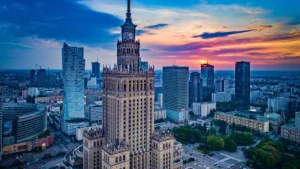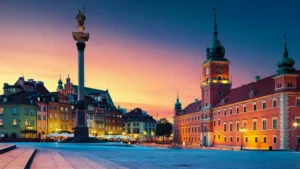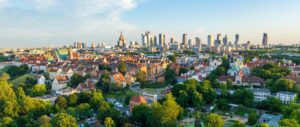

Ultimate Guide to Warsaw Trip: Attractions and Activities
A Respect for History
Eighty years ago, Nazi Germany aimed to wipe Warsaw from the face of the earth—a goal that was nearly achieved by the end of WWII. However, Varsovians are nothing if not tenacious. Out of the rubble and ashes, it is miraculous what has survived; some of which is now preserved in the city’s top museums.
Start in the Old Town, a remarkable reconstruction of how this part of Warsaw looked in the 17th and 18th centuries. Here, the innovative Museum of Warsaw displays thousands of eclectic objects, illuminating different aspects of the city’s history. The museum has several other branches scattered around the Old Town that are worth searching out, as well as the equally impressive Praga Museum of Warsaw over on Warsaw’s east side across the Vistula River.
Next, deepen your understanding of the city’s darkest days at the exceptional Warsaw Rising Museum. Housed in a former tram power station, this museum thoroughly covers the heroic but doomed uprising against the German occupation in 1944 through an immersive range of interactive displays, including archival films and personal accounts.
Additionally, the award-winning POLIN Museum of the History of Polish Jews leaves practically no stone unturned in documenting a millennium of Jewish life in Poland. The multimedia permanent exhibition showcases the rich contributions of Jewish culture to Poland, before the devastating loss during WWII. The museum’s stunning contemporary building, designed by Finnish architectural firm Lahdelma & Mahlamäki, is a sight in itself amidst the former Jewish ghetto.
Amazing Architecture

From medieval churches and revamped art nouveau market halls such as Hala Koszyki to a flying saucer-shaped former railway ticket office that now serves as a café, Warsaw boasts an impressive architectural display. Many of the city’s most historic buildings, including the Royal Castle, are restorations or total recreations but remain striking.
During the Communist era, the socialist realist style was showcased at the Marszałkowska Residential District (MDM) with its chiselled heroic worker reliefs and the massive pair of candelabra on Plac Konstytucji, alongside the monolithic Palace of Culture & Science—a 1950s ‘gift’ from the USSR to Poland. To see some of the grand interior architecture of this vast complex, consider joining the guided tour offered by Creatours.
In recent years, the trendy café/bar/theatre and gallery, Studio Teatrgaleria, has spearheaded projects to revitalize part of the somewhat forlorn Plac Defilad surrounding the complex. Between May and August, events such as film screenings and concerts are held in front of the Palace’s main eastern entrance. In winter, you can rent ice skates to enjoy the ice rink set up in front of the northern entrance.
Other noteworthy contemporary buildings include the Copernicus Science Centre, which offers a fun and hugely popular interactive learning experience, and Warsaw University Library, adorned with monumental copper panels on its facade, symbolizing pages of books. In summer, the library’s rooftop garden provides a relaxing spot to enjoy stunning views.
The Great Outdoors
Since 2014, Warsaw has hosted an architecture award; the 2018 winner, the Vistulan Boulevards, is an imaginatively landscaped promenade that refocuses attention on the river that splits the city. On the Vistula’s east bank, footpaths lead through riverside woods to Rusałka Beach, a popular spot for Varsovians to unwind and soak up the sun during warmer months—one of several beaches along the river.
The former royal hunting ground of Łazienki Park has been transformed over the centuries to include themed gardens, palaces, an ornamental lake, and an amphitheatre. This park is home to the Chopin Monument, a fabulous art nouveau bronze statue beside which free piano recitals by award-winning musicians occur every Sunday from mid-May to September.
Another delight for nature lovers is the expansive 45-hectare Wilanów Park, which encircles Wilanów Palace, located 12km southeast of the city center. The park features Baroque Italian gardens, a Renaissance-inspired rose garden, and an English-style landscape park. Even in winter, the park is a worthwhile visit, as it transforms nightly with colorful illuminations.
Art and Design

While visiting Wilanów, don’t miss the Poster Museum in the palace’s renovated stable block. Polish poster designers have gained international acclaim for their original works: some wonderful examples are displayed in the regularly changing exhibitions here, and you can purchase classic images in the shop. Back in the city center, Galeria Plakatu Polskiego offers the best selection of original and reproduction posters for sale.
Several centuries of outstanding Polish art and design are showcased at the National Museum. The eye-popping collection spans from medieval religious icons to dazzling decorative arts. The museum’s Polish Design Gallery displays iconic pieces such as Ćmielów porcelain, 1960s fabric prints, and Teresa Kruszewska’s 1973 ‘Tulip’ armchair.
Art is not confined to galleries in Warsaw—it can be found in the form of giant Communist-era mosaics decorating the sides of buildings, as well as contemporary painted murals. The old industrial buildings and tenements of Praga have particularly become favored canvases for street artists, thanks to events such as Street Art Doping. Preserving another Varsovian art form is the Neon Museum, a vibrant retirement home for iconic communist-era neon signs.
The Museum of Modern Art is also working to ensure that art has prominence outside of formal gallery walls. While awaiting a permanent home to be built on the north side of Plac Defilad, it has a temporary exhibition space at the Museum on the Vistula: the exterior of this pavilion is adorned with a 1600 sq m work by Sławomir Pawszak, Poland’s largest painting. Another project by the museum is the Bródno Sculpture Park, which brings contemporary works to Warsaw’s northeastern suburbs.
Eat, Drink and Be Merry
Having nourished your mind and spirit with the best of Warsaw, it’s now time to satisfy your appetite. Regardless of your budget, you won’t be disappointed. Milk bars (bar mleczny) are super cheap self-service canteens that are a relic from communist times. They serve hearty Polish food, primarily vegetarian or dairy-based, hence the name. The best of these establishments, such as Prasowy, boast a contemporary makeover of their proletarian decor.
If you’re in town for the weekend, be sure to visit Hala Gwardii. This 1902 art nouveau market hall, which once hosted boxing matches, is now filled with hipster street-food outlets, craft beer bars, and third-wave coffee kiosks.
If a more traditional Polish dining experience is what you seek, romantic Dom Polski in chic Saska Kępa is an excellent choice. For something more contemporary, and to experience local chefs working at the top of their game, be sure to book ahead for Bez Gwiazdek or Zoni, both of which present menus that provide a modern twist on historical and regional Polish recipes.
Zoni is part of Koneser, a multifunctional complex representing the latest chapter in the hip redevelopment of Praga. Here, top brands of Polish vodka were once produced in the attractive red brick buildings, as you’ll discover at the interactive Polish Vodka Museum. Take the tour to learn everything you need to know about the spirit—culminating in a tasting of three types of vodka: na zdrowie (cheers)!



